A highly symbolic, highly effective advertisement by Grumman aircraft, specifically focusing on production of the F6F Hellcat fighter plane.
The emblem of the 7th War Loan would place the date at somewhere after May 7, 1945.
Before NCR was “NCR”, the company was appropriately known as the National Cash Register Corporation. After having been acquired by ATT in 1991, a 1996 restructuring of that firm led to the spin-off Lucent Technologies and NCR, with the firm being the only “spun-off” company that has retained its name.
This advertisement, from August 9, 1943, illustrates the company’s National Class 3000 Bookkeeping Machine.
The advertisement is quite simple in style and design. A sketch of a model using an NC 3000 is repeated four times in the same illustration, giving an impression of “depth” and activity as in – well, quite appropriately! – an office setting. An example of a neatly completed bill appears in the background.
The full text of the advertisement appears at bottom. Note the use of alpha-numeric telephone number prefixes (“CIrcle”, “MOtt”, and “CAnal”).
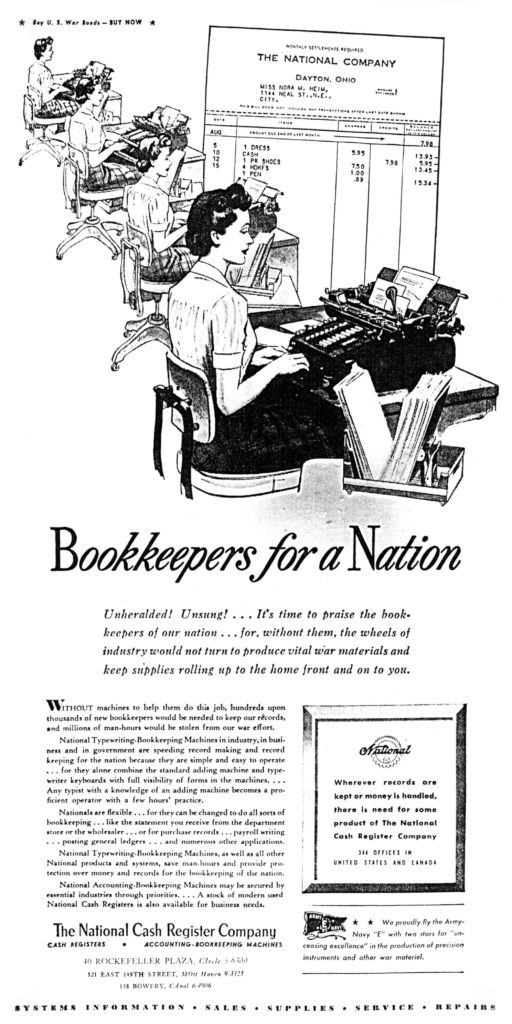 Here’s an illustration of an NC 3000 from the Office Museum website:
Here’s an illustration of an NC 3000 from the Office Museum website:
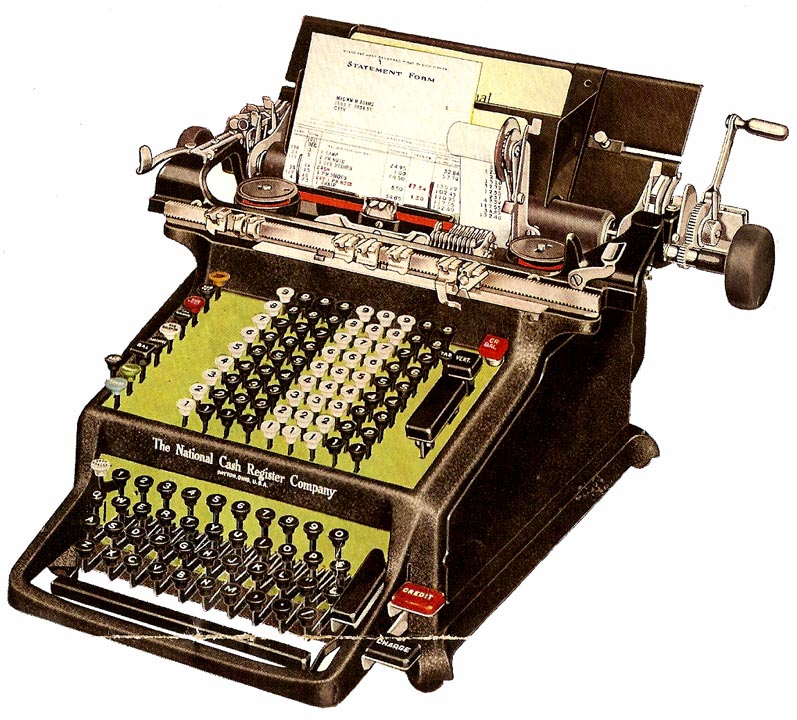 These two images – showing the front and rear of an NC 3000, on its stand – are from the Smithsonian’s Museum of American History website. This example was manufactured in 1938 or 1939.
These two images – showing the front and rear of an NC 3000, on its stand – are from the Smithsonian’s Museum of American History website. This example was manufactured in 1938 or 1939.
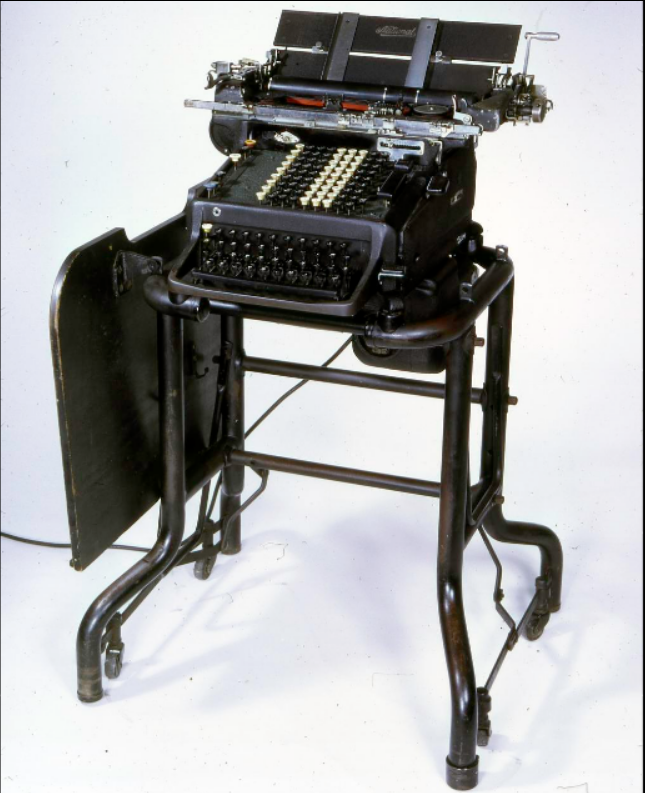
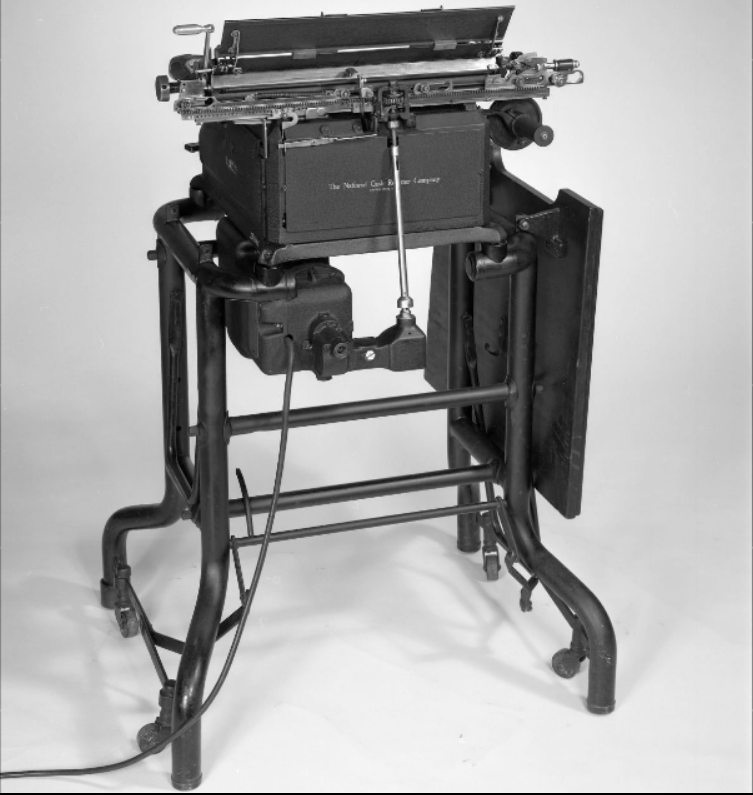 Without machines to help them do this job, hundreds upon thousands of new bookkeepers would be needed to keep our records, and millions of man-hours would be stolen from our war effort.
Without machines to help them do this job, hundreds upon thousands of new bookkeepers would be needed to keep our records, and millions of man-hours would be stolen from our war effort.
National Typewriting-Bookkeeping Machines in industry, in business and in government are speeding record making and record keeping for the nation because they are simple and easy to operate…for they alone combine the standard adding machine and typewriter keyboards with full visibility of forms in the machines… Any typist with a knowledge of an adding machine becomes a proficient operator with a few hours’ practice.
Nationals are flexible…for they can be changed to do all sorts of bookkeeping…like the statement you receive from the department store or the wholesaler…or for purchase records…payroll writing…posting general ledgers…and numerous other applications.
National Typewriting-Bookkeeping Machines, as well as all other National products and systems, save man-hours and provide protection over money and records for the bookkeeping of the nation.
National Accounting-Bookkeeping Machines may be secured by essential industries through priorities… A stock of modern used National Cash Registers is also available for business needs.
The National Cash Register Company
CASH REGISTERS * ACCOUNTING – BOOKKEEPING MACHINES
40 ROCKEFELLER PLAZA, CIrcle 5-6300
321 EAST 149TH STREET, MOtt Haven 9-3323
138 BOWERY, CAnal 6-4906
References
Early Office Museum – Antique Special Purpose Typewriters, at http://www.officemuseum.com/typewriters_office_special.htm
Mathematical Treasure: National Class 3000 Bookkeeping Machine on Stand, at http://americanhistory.si.edu/collections/search/object/nmah_694189
NCR Corporation, at https://en.wikipedia.org/wiki/NCR_Corporation
National Museum of American History – Bookkeeping Machines, at http://americanhistory.si.edu/collections/object-groups/bookkeeping-machines/national
This advertisement is particularly eye-catching in its use of light and dark, which visually symbolizes its message: An organization, operating regardless of day or night, producing vitally needed products for the military. The company? Reeves Sound Laboratories.
Located at 215 East 91st Street in Manhattan (unfortunately, there does not seem to be a Google street view of the address), the company, founded by Hazard E. Reeves, was a division of Reeves-Ely Laboratories, and conducted research into advanced gunfire control systems and computers, radar and tracking systems, guided missile controls, aircraft control instruments, flight trainers and aerodynamical computers, precision instruments, servo mechanisms, and, sound recording systems. By 1956, the company merged into the Dynamics Corporation of America.
AND OVER BERLIN – BOMBER CREWS ARE USING A PRODUCT MADE JUST OFF BROADWAY
Previously, the cutting of crystal oscillators had been an art known to only a few technicians. But then these New Yorkers pitched in: Debutantes, dancing teachers, actors, stenographers, artists, clerks, butcher boys, beauticians, models and others joined hands with housewives to show what they could do when a war industry came to Times Square.
Over a thousand workers (mostly women) came from the five boroughs and the suburbs. Everyone started from scratch. Management and workers were unskilled at the start. They learned the job together under the guidance of the United States Army Signal Corps experts. Production processes were studied and broken down into the simplest possible operations. X-Ray equipment and other highly scientific apparatus were brought in to help.
In the first month, only a few crystal were produced. Now a year later, these people are turning out many more crystals than was believed possible a year ago.
A production miracle? Perhaps. But maybe it’s because these people are Americans – because they’re New Yorkers…or because a large percentage of the employees have relatives doing the toughest job of all – in the Armed Service of their country.
These workers have done their work so well that they have been awarded the Army-Navy “E” which they accept with this pledge:
“I promise to wear this pin as a promise to every man in our Armed Services that, until this war is won, I will devote my full energies to the cause for which they are giving their lives.”
First to fly above Times Square, this pennant will give promise of even greater things in store for ’44.
For a fascinating glimpse into the Lab’s activities with a direct connection to the advertisement, watch the 1943 video Crystals Go To War, (at Jeff Quitney’s channel) – “narration by one of the research scientists of the U.S. Army Signal Corps” – produced for Reeves Sound Laboratories by Andre deLaVarre. The film is also available at Archiv.org.
References
Industrial Research Laboratories of the United States – Including Consulting Research Laboratories (Bulletin of the National Research Council) Number 113; July, 1946. Compiled by Callie Hull, with the assistance of Mary Timms and Lois Wilson.
Hazard E. Reeves, at https://en.wikipedia.org/wiki/Hazard_E._Reeves
Reeves Instrument Corporation, at https://en.wikipedia.org/wiki/Reeves_Instrument_Corporation
Here’s an advertisement from January 18, 1945 for a company that – refreshingly! – exists even today: American Car and Foundry.
Formed and incorporated in Jew Jersey in 1899, the firm is located today in Milton, Pennsylvania. According to the Wikipedia entry, the manufacturing facility, “…is capable of manufacturing railcars and all related railcar components. The plant is capable of producing pressure vessels in sizes 18,000–61,000 gwc, including propane tanks, compressed gas storage, LPG storage, and all related components, including heads. The plant, covering 48 acres, provides 500,000 square feet of covered work area and seven miles of storage tracks.”
(How nice to know that something physical is still manufactured in the United States!)
Regarding the advertisement itself, the illustration is a very nice example of graphic art. Every major product manufactured by the company is presented, from (primarily) railroad cars, to naval vessels, to shells or bombs, and (it looks like…) tires, with every manufactured item “leading” back to a point on a simplified map showing the location of its relevant manufacturing facility. Above all, the use of light and shadow is quite striking.
The full text of the ad is presented below.
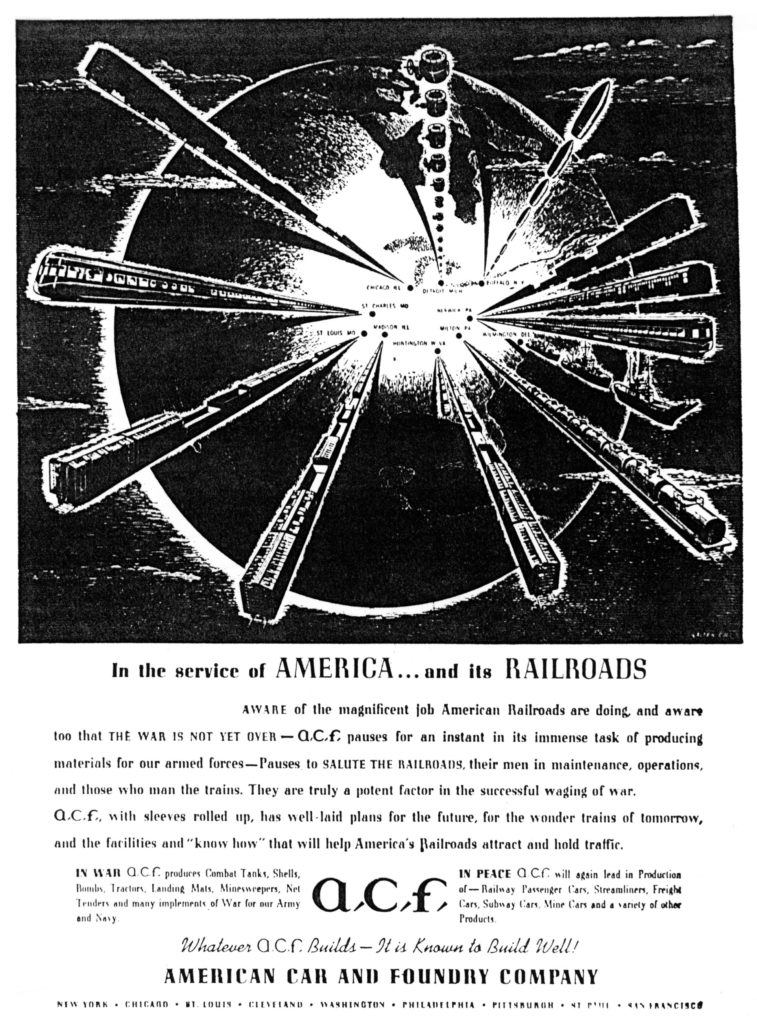 In the service of AMERICA … and its RAILROADS
In the service of AMERICA … and its RAILROADS
AWARE of the magnificent job American Railroads are doing, and aware too that THE WAR IS NOT YET OVER – A.C.F. pauses for an instant in its immense task of producing materials for our armed forces – Pauses to SALUTE THE RAILROADS, their men in maintenance, operations, and those who man the trains. They are truly a potent factor in the successful waging of war.
A.C.F., with sleeves rolled up, has well-laid plans for the future, for the wonder trains of tomorrow, and the facilities and “know how” that will help American’s Railroads attract and hold traffic.
IN WAR A.C.F. produces Combat Tanks, Shells, Bombs, Tractors, Landing Mats, Minesweepers, Net Tenders and many implements of War for our Army and Navy.
IN PEACE A.C.F. will again lead in Production of – Railway Passenger Cars, Streamliners, Freight Cars, Subway Cars, Mine Cars and a variety of other Products.
Whatever A.C.F. Builds – It is Known to Build Well!
References
ACF Industries, LLC, at http://acfindustries.com/
American Car and Foundry, at https://en.wikipedia.org/wiki/American_Car_and_Foundry_Company
American Car and Foundry has survived; other corporations have not.
Among them, Pennsylvania Railroad.
The advertisement below – from January 15, 1945 – has a title that proved to be as optimistic as it was ironic, for after merging with New York Central Railroad in 1968, the resulting firm, the Penn Central Transportation Company, filed for bankruptcy in 1970.
The advertisement combines three elements to produce a striking image. On the left, symbolizing the future, new designs for railroad cars are displayed on a unfurled blueprint, against which are placed a T-square and right triangle. Translucent images of those “future” railroad cards are shown below. On the right, a fleet of existing freight and railroad cars, en route from “a city” and “factory” pass by a suburban rail station. In the background, stylized images of that city and factory are set against the horizon of a cloudless sky, surrounded by farmland. Above all is the emblem of the Pennsylvania Railroad.
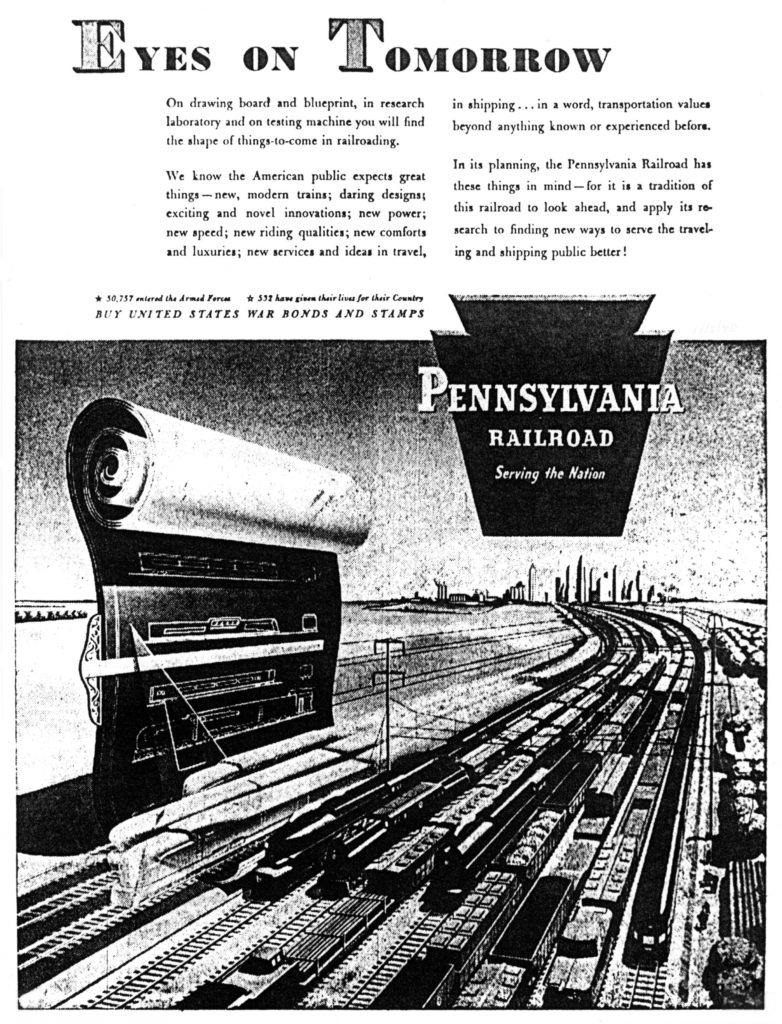 Though “this” example of the advertisement was published in The New York Times, certainly the original advertisement was in color, and probably intended for publication in magazines. Here’s an example of the original ad, from Pinterest:
Though “this” example of the advertisement was published in The New York Times, certainly the original advertisement was in color, and probably intended for publication in magazines. Here’s an example of the original ad, from Pinterest:
Here is the full text of the advertisement:
EYES ON TOMORROW
On drawing board and blueprint, in research laboratory and on testing machines you will find the shape of things-to-come in railroading.
We know the American public expects great things – new, modern trains; daring designs; exciting and novel innovations; new power; new speed; new riding qualities; new comforts and luxuries; new services and ideas in travel, in shipping … in a word, transportation values beyond anything known or experienced before.
In its planning, the Pennsylvania Railroad has these things in mind – for it is a tradition of this railroad to look ahead, and apply its research to finding new ways to serve the traveling and shipping public better!
★ 50,757 entered the Armed Forces ☆ 532 have given their lives for their Country
BUY UNITED STATES WAR BONDS AND STAMPS
That the advertisement was created during the Second World War is strikingly evident by one particular facet of the text: The number of Pennsylvania Railroad Employees who died on WW II military service. Though listed as 532, the actual number is more than twice as many: 1,307. The discrepancy was likely attributable to the fact that the advertisement was created before the war actually ended, and thus, well before the status of all casualties (especially those missing in action) was verified.
The 1,307 men are memorialized at Philadelphia’s 30th Street Station, in the form of a bronze sculpture showing the Archangel Michael lifting a fallen soldier out of the “flames of war”. The sculpture is set atop a four-sided black granite base, upon the sides of which are bronze plaques listing the soldiers’ names in alphabetical order, and, bearing symbols of the four branches of the armed forces.
Designed by Walter Hancock and unveiled in 1952, the sculpture is – even decades later – extraordinarily striking.
References
Pennsylvania Railroad, at https://en.wikipedia.org/wiki/Pennsylvania_Railroad
Pennsylvania Railroad World War II Memorial, at https://en.wikipedia.org/wiki/Pennsylvania_Railroad_World_War_II_Memorial
Here’s an advertisement for Robinson Aviation / Robinson Airlines, from 1945, featuring a sketch of a Fairchild F24.
The airline was founded in 1945 by C.S. Robinson, and was based out of Ithaca Municipal Airport, at Ithaca, New York, servicing routes in the Mohawk Valley of New York State. Renamed Mohawk Airlines in 1952, the company survived until the early 1970s, when it merged with Allegheny Airlines.
Mohawk Airlines (Wikipedia), at https://en.wikipedia.org/wiki/Mohawk_Airlines.
An advertisement for Motorola Radio, from 1945.
The Galvin Manufacturing Corporation (listed at the bottom of the advertisement) the actual progenitor of Motorola, was founded in 1928 in Chicago by brothers Paul V. and Joseph E. Galvin. They originated the name “Motorola” in 1930 by “…linking “motor” (for motorcar) with “ola” (from Victrola)”, selling their first Motorola brand name radio that year.
The text of the advertisement?…
“Funny-looking gadget, that old-time radio set. Big, bulky born…dials and more dials…squeaky and noisy as all get out. Not much like the radio now in your living-room or car. And yet the radio you buy not too long after the war may make your present-day set look and sound as antiquated as that early Electronic instrument looks now. Today Electronics is fighting for America and its Allies brilliantly and successfully. In battle it warns of approaching danger so can can destroy the enemy; in the electric eye it searches for and exposes flaws in heavy castings; in resistance-welding it doubles and triples production. These and countless others are Electronic achievements of vast importance now and for the future. The first Electronic instrument to benefit will be radio.
Your First Post-War Electronic Purchase Should be a Motorola Radio
Motorola Engineers are making full use of the newest Electronic knowledge in the production and development of Radar and Communications Equipment now being used by American fighting men on every battle front. Soon after Victory gives the green light to civilian production, the “know-how” of Motorola Engineers will be switched to the production of civilian radios for home and car with the same all-out efficiency and perfection. Expect the finest in radio from Motorola.
Take good care of your radio. It is a vital wartime necessity. For service, consult your local classified telephone directory for a nearby Motorola Dealer.”
Motorola (wikipedia), at https://en.wikipedia.org/wiki/Motorola#cite_note-16
Here are dueling advertisements from 1945 for Coca-Cola, and, Pepsi (Cola), the former from The New York Times, and the latter from that same newspaper or (hmmm…?) The Philadelphia Inquirer.
Though Coca-Cola used the image of a fighter pilot to promote their product, the advertisement carries no mention of – and implies no endorsement by – the Army Air Force. It’s the visual symbolism that counts.
Interestingly, given that the pilot is seated in a Razorback version of the P-47D Thunderbolt fighter plane and wearing “early” style two-piece goggles, perhaps the Coca-Cola company created this ad by using a stock publicity photo from earlier in the, war as a basis for the advertisement.
The Pepsi ad? Simple, and to-the-point.
They’re both still around. Many things change, but a few remain the same!